RBSE Solutions for Class 12 Biology Chapter 5 Principles of Inheritance and Variation
Rajasthan Board RBSE Solutions for Class 12 Biology Chapter 5 Principles of Inheritance and Variation Textbook Exercise Questions and Answers.
Rajasthan Board RBSE Solutions for Class 12 Biology in Hindi Medium & English Medium are part of RBSE Solutions for Class 12. Students can also read RBSE Class 12 Biology Important Questions for exam preparation. Students can also go through RBSE Class 12 Biology Notes to understand and remember the concepts easily. Browsing through manav janan class 12 in hindi that includes all questions presented in the textbook.
RBSE Class 12 Biology Solutions Chapter 5 Principles of Inheritance and Variation
RBSE Class 12 Biology Principles of Inheritance and Variation Textbook Questions and Answers
Question 1.
Mention the advantages of selecting pea plant for experiment by Mendel.
Answer:
Mendel’s experimental plant was a common garden pea (Pisum sativum). He selected garden pea for the following reasons:
- The pea plant is small, annual and easy to grow.
- The plant is naturally self - pollinating but can be easily cross - polinated experimentally.
- It reproduces a large number of offspring and completes its life cycle in one season.
- A large number of true breeding varieties of pea are available.
- The plants had a number of contrasting characters, for example, red vs. white flowers, round vs. wrinkled seeds etc.
- Mendel ensured the plant as true breeding by allowing successive generations of each variety to self pollinate to eliminate any offspring that was not true to the form of the trait.

Question 2.
Differentiate between the following:
(a) Dominant and Recessive.
(b) Homozygous and Heterozygous.
(c) Monohybrid and Dihybrid.
Answer:
(a) Difference between Dominance and Recessive:
|
Dominance |
Recessive |
|
When a factor (allel) express itself in the presence or absence of its recessive factor, called dominance. |
It can only express itself in the absence of its dominant factor or allele. |
|
Example: In a pea plant, round seeds, violet flower or dominant characters. |
Example: In a pea plant, white flower dwarf plant etc., are recessive characters. |
(b) Difference between Homozygous and Heterozygous:
|
Homozygous |
Heterozygous |
|
1. They have similar alleles (TT or tt) for a trait. |
1. They have dissimilar (Tt) for a trait. |
|
2. Contains either dominant (TT) or recessive (tt) alleles but not both types. |
2. Contains both, dominant and recessive alleles. |
|
3. They are true breeding for a specific trait and produce progeny having same genotypes and phenotypes on selfing. |
3. They are not true breeding and produce offspring having three genotypes and mostly two or some time three phenotypes. |
|
4. Only one type of gametes are produced either 'T' or‘t’ type only, not both. |
4. Produce two types of gametes containing ‘T’ as well as ‘t’. |
(c) Difference between Monohybrid and Dihybrid Cross
|
Monohybrid Cross |
Dihybrid Cross |
|
1. It is a cross between parents differing in only one pair of contrasting characters. |
1. It is a cross between parents differing in two pairs of contrasting characters. |
|
2. Example: A cross between a dwarf and a tall pea plant. |
2. Example: A cross between yellow wrinkled seed and a green round seed. |
Question 3.
A diploid organism is heterozygous for 4 loci, how many types of gametes can he produced?
Answer:
For a diploid organism, which is heterozygous for 4 loci then 24 i. e., 2 x 2 x 2 x 2 = 16 types of gametes can be produced if the genes are not linked because for each heterozygous pair of genes, there are two possibilities. So, for 4 pairs, the number of combination will be 16 gametes.
Question 4.
Explain the law of dominance using a monohybrid cross.
Answer:
When two different factors (genes) or a pair of contrasting forms of a characters are present in an organism, only one expresses itself in the F1 generation and is termed as dominant while the other remains unexpressed and called recessive factor (gene).
Example: when a monohybrid cross between tall (TT) and dwarf (tt) pea plants was carried out, all the plants in F1 generation were observed to be tall (Tt). Here tallness is dominant over dwarfness which expressed itself and the dwarfness got suppressed.

Question 5.
Define and design a test cross.
Answer:
A test cross can be defined as a cross of an F1 individual that has a dominant phenotype with its homozygous recessive parent. Test cross can be used to determine if an individual displaying dominant character is homozygous or heterozygous.
Example: When a cross is made between tall (TT) pea plant and dwarf (tt) pea plant, the F1 offspring show all tall plant. If the F1 plants crossed with dwarf parent plants producing tall and dwarf plants in the equal proportion i.e., 1:1 ratio is observed.
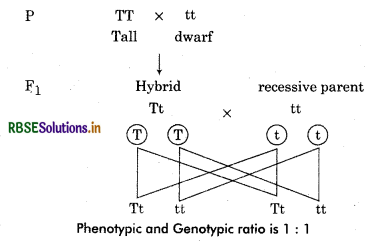
Question 6.
Using a punnet square, workout the distribution of phenotypic features in the first filial generation after a cross between a homozygous female and a heterozygous male for a single locus.
Answer:
Male forms two types of gametes containing either T or t factor while female forms only one type of gametes containing t factor only. Hence, both types of phenotypes appear in equal proportion.
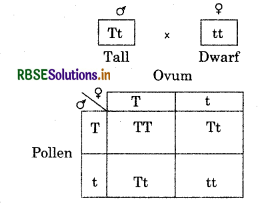
Question 7.
When a cross is made between tall plant with yellow seeds (Tt Yy) and tall plant with green seed (Tt yy), what proportion of phenotype in the offspring could be expected to be:
(a) tall and green,
(b) dwarf and green.
Answer:
When a cross is made between tall plants with yellow seeds (Tt Yy) and tall plant with green seed (Tt Yy), the phenotypic proportion in the offspring could be expected are three tall and green, one dwarf and green.
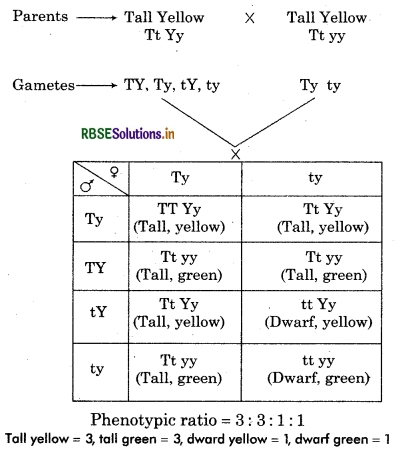
Question 8.
To heterozygous parents are crossed. If the two loci are linked what would be the distribution of phenotypic features in F1 generation for a dihybrid cross?
Answer:
If the two loci are linked, there will be two possibilities:
(a) If the genes are completely linked. In the case of complete linkage, all the offspring will show parental phenotypes.
(b) If the genes are incompletely linked, in complete linkage, there is occurrence of crossing over and new combinations are formed but the parental combinations are more numerous than the new or non - parental combinations.
Question 9.
Briefly mention the contribution of T.H. Morgan in genetics.
Answer:
Thomas Hunt Morgan (1886 - 1945) was an American scientist. Famous for his experimental - research with Drosophila (fruit fly) by which he established the chromosome theory of heredity. He showed that genes are linked in a series on chromosomes and are responsible for identifiable, hereditary traits. Morgan’s work played a key role in establishing the field of genetics, he got the Noble prize for Physiology or Medicine in 1933.

Question 10.
What is pedegree analysis? Suggest how such an analysis, can be useful?
Answer:
A pedigree is a diagram of a family tree showing the relationships between individuals together with relevant facts about their medical histories. A pedigree analysis is the interpretation of these data that allows a better understanding of the transmission of genes within the family. In human genetics, pedigree study provides a strong tool, which is utilized to trace the inheritance of a specific trait, abnormality or disease. By carefully observing the position of affected individuals, mutation carriers may be identified. From this data, the risk of carrier status for other family members or the chance that a couple may have an affected child can be estimated.
Question 11.
How is sex determined in human beings?
Answer:
Human beings show XY type of sex determination. In human sex chromosomes male is XY while those of female is XX. The male can produce gametes (sperms) containing either X or Y sex - chromosomes whereas, female can produce gametes (ovum) containing only X - chromosomes. When Y chromosome containing gamete of male fertilizes with either X containing gamete of female, foetus will be a male. When X chromosome containing gamete of male fertilizes with either of female gamete, foetus will be a female.
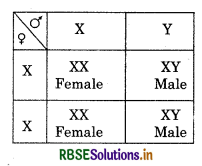
Question 12.
A child has blood group ‘O’. If the father has blood group ‘A’ and mother blood group 'B' Work out the genotype of the parents and the possible genotypes of the other offspring.
Answer:
Blood group in human is controlled by three kinds of alleles IA, IB and IO. IA and IB are co - dominant whereas IO is recessive. IA codes for blood group A whereas IB codes for blood group B. IO codes for blood group O.
A person having blood group A can have two possible allele combinations: IAIA or IAIO.
A person having blood group B can have also two allele combinations: IBIB or IBIO.
When both IA and IB are present then the blood group will be AB and when both of these are absent then the blood group will be O (IOIO).
In the above case since the father and mother have dominant alleles and yet the child shows the recessive phenotype, the dominant A and B alleles in the parent must be present in the heterozygous condition. This is because if the alleles were present in homozygous condition in any of the parent then the child would show dominant phenotype and not the recessive phenotype.
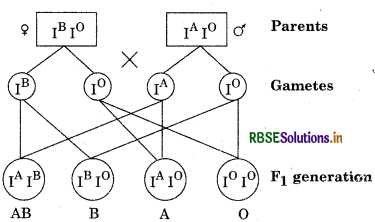
Therefore, we can see that in the above situation the other offspring could show A, B or AB blood group.
Question 13.
Explain the following terms with example:
(a) Co - dominance.
(b) Incomplete dominance.
Answer:
(a) Co - dominance: When both the contrasting alleles of a gene pair are equally expressed, this phenomenon is called as co - dominance. For example, human blood group, both A and B are equally dominant and when present together exhibit the AB blood group instead of either A or B.
(b) Incomplete dominance: When a dominant allele does not completely mask the effects of a recessive alleles, and the organisms resulting physical appearance shows a blending of both allele. It is called incomplete dominance. For example, flower colour in snapdragon plant, Red flower colour (R) is incompletely dominant over the white (r). When both alleles R and r are present together. R is unable to completely suppress r and therefore the resulting phenotype is pink coloured flower.
Question 14.
What is point mutation? Give one example.
Answer:
Mutations arising due to change in single base pair of DNA is called point mutation.
Example: Sickle cell anaemia, haemophilia.
Question 15.
Who had proposed the chromosomal theory of the inheritance?
Answer:
Sutton and Boveri in 1902 proposed the chromosomal theory of inheritance.
Question 16.
Mention any two autosomal genetic disorders with their symptoms.
Answer:
(a) Down's Syndrome: It is caused due to trisomy of 21st chromosomes. The abnormal children are mentally retarded, have widely placed eyes and open mouth with tongue out. Younger women do not show this abnormality because in them there is complete disjunction of chromosomes.
(b) Patau's Syndrome: It is caused by a condition when an individual has extra chromosome of 13th pair. It results in abnormality in posterior part of the heel, cleft, lip and palate. It creates mental retardation and malformation of organs.

- RBSE Class 12 Biology Notes Chapter 16 पर्यावरण के मुद्दे
- RBSE Class 12 Biology Notes Chapter 15 जैव-विविधता एवं संरक्षण
- RBSE Class 12 Biology Notes Chapter 14 पारितंत्र
- RBSE Class 12 Biology Notes Chapter 13 जीव और समष्टियाँ
- RBSE Class 12 Biology Notes Chapter 12 जैव प्रौद्योगिकी एवं उसके उपयोग
- RBSE Class 12 Biology Notes Chapter 11 जैव प्रौद्योगिकी-सिद्धांत व प्रक्रम
- RBSE Class 12 Biology Notes Chapter 10 मानव कल्याण में सूक्ष्मजीव
- RBSE Class 12 Biology Notes Chapter 9 खाद्य उत्पादन में वृद्धि की कार्यनीति
- RBSE Class 12 Biology Notes Chapter 8 मानव स्वास्थ्य तथा रोग
- RBSE Class 12 Biology Notes Chapter 7 विकास
- RBSE Class 12 Biology Notes Chapter 6 वंशागति के आणविक आधार